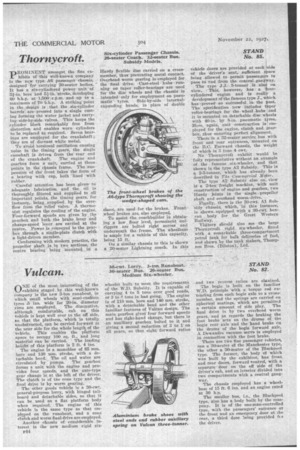Vulcan.
Page 168

If you've noticed an error in this article please click here to report it so we can fix it.
COTE of the most interesting of the k_sw exhibits staged by this well-known company is the new 3-ten runabout, in which small wheels with semi-cushiria tyres .5 ins. wide for 20-in, diameter rims are employed. The diminutive, although comfortable, cab on this vehicle is kept well over to the off side, ,so that the platform, which is totally unobstructed, can be carried forward at the near side for the whole length of the vehicle. This enables the platform space to occupy 100 sq. ft., and long material can be carried. The loading height of this platform is 2 ft. 4 ins.
The engine is a monobloc of 85 mm. bore and 130 ram. stroke. with a detachable head. The oil and water are circulated by pumps. The gearbox forms a unit -with the engine and provides four speeds, and the gate-type gear change is at the left of the driver. The clutch is of tee cone type and the final drive is by worm gearing.
The other goods vehicle is a 30-cwt. general-purpose lorry, with hinged tailboard and detachable sides, so that it can be used as a flat platform body when required. The engine of this vehicle is the same type as that emplayed on the runabout, and a cone clutch and worm final drive are employed.
Another chassis of considerable interest is the new medium rigid six F44
wheeler built to meet the requirements of the W.D. Subsidy. It is capable of carrying 4 to 5 tons over good roads, or 3 to d tons in bad going. The engine is of 110 mm. bore and 140 nom. stroke, with a detachable head and the other familiar features of Vulcan design. The main gearbox gives four forward speeds and has right-hand change, but there is an auxiliary gearbox bolted to it and giving a second reduction of 3 to 1 on all gears, so that eight forward ratios
and two reverse ratios are obtained.
The bogie is built on the familiar W.D. principle 'with a torque rod ex'tending from each bogie axle to a crossmember, and the springs are carried on spherical seatings, which are permitted a certain amount of side play. The final drive is by two overhead worm gears, and as regards the braking the foot brake 'acts on the drums of the hogoe rear axle and the hand brake on the drums of the bogie forward axle. A Dewandre vacuum servo is employed in connection with the foot brake.
There are two fine passenger vehicle., one a 30-seater of the Manchester type, the other a 20-seater of the Blackpool type. The former, the body Of which was built by the exhibitor, has front and rear doors, forward txmtrol, with a separatedoor on the off side of the driver's cab, and an interior divided into two compartments with a central gangway.
The chassis employed has a wheelbase of 15 ft. 6 ins, and an engine rated at 30 h.n.
The smaller bus, i.e., the Blackpool type, also has a body built by the company. It is of the one-man-controlled type, with the passengers' entrance at the front and an emergency door at the rear, -a• third door being provided fcr the driver.


















































































































































































































































































































